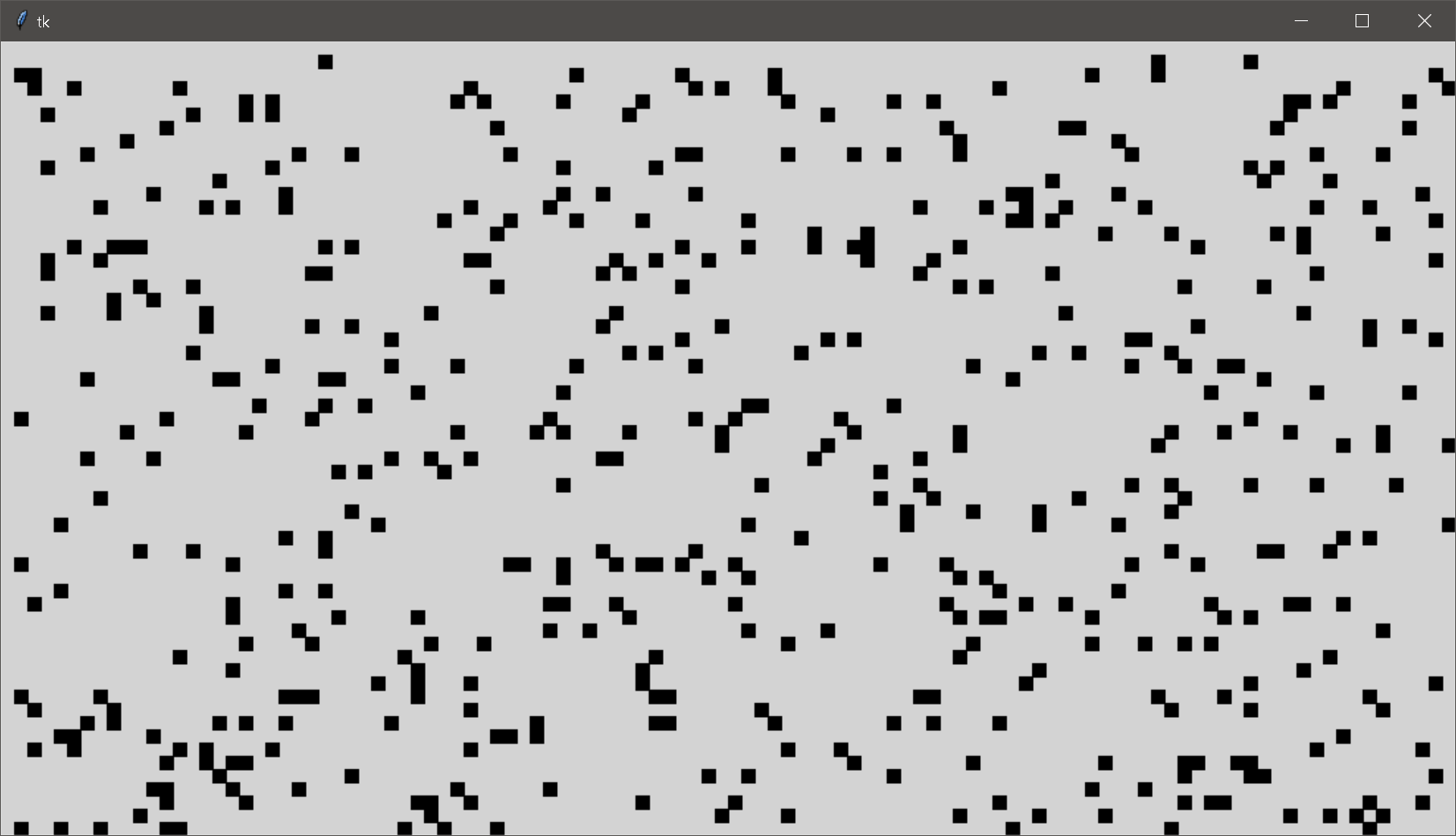Let's create game of life with Python !
Game of life (which is not a game) is a good programming excercise and it is quite funny. This cellular automation was invented by a mathematician named John Conway.
This is very easy to understand: it consists of a grid of cells which can live, die or multiply based on three rules:
- 1 - Each cell with one or no neigbhors die by soliture
- 2 - Each cell with four or more neigbhors dies by overpopulation
- 3 - Each cell with two or three neigbors survives
You can have more informations here .
Let’s create it !
We will use Python, so basic knowledge of Python is required. To create a GUI (graphical user interface), we will use the Python library Tkinter. More infos about Tkinter here .
Create the GUI
Create a python file, you can name it main.py or any other name.
from tkinter import Tk, Canvas
window = Tk()
window.geometry(str(600) + "x" + str(600))
canvas = Canvas(window, width=600, height=600, borderwidth=0, highlightthickness=0, bg='lightgray')
canvas.pack()
window.mainloop()Here we create a window with Tkinter of 600 by 600 and a canvas to draw the cells.
We will represent the cells with a list of lists. Since the GUI window is 600 x 600, our cells list wil be 60 x 60. An alive cell is represented with the value 1 and a dead one with the value 0. So, to begin, we fill our list with dead cells.
cells = []
for i in range(60):
cells.append([0] * 60)Then, we generate random alive cells, here 500. So we give them the value one.
for i in range(500):
x = random.randint(1, 59)
y = random.randint(1, 59)
cells[x][y] = 1Don’t forget to import the random module :
import random
Now we want to display on the window our cells. For that, we will create a function displayCells.
def displayCells():
canvas.delete("all")
for x in range(60):
for y in range(60):
if cells[x][y] == 1:
xx = x * 10
yy = y * 10
c="black"
canvas.create_rectangle(xx, yy, xx+10, yy+10, fill=c)We will call displayCells in a loop to display the new cells on the window. Here, we delete the precedent cells with canvas.delete("all") and we loop through the cells list to display a 10x10 black rectangle if the cell is alive.
As we will want to call others functions in the main program loop, we can create a function programLoop.
def programLoop():
displayCells()And add this to call the programLoop function on the window
window = Tk()
window.geometry(str(600) + "x" + str(600))
canvas = Canvas(window, width=600, height=600, borderwidth=0, highlightthickness=0, bg='lightgray')
canvas.pack()
#the programLoop function will be called 100 milliseconds after the program runs
window.after(100, programLoop)
window.mainloop()The result must looks like something like this:
Make the cells evolve
To make the cells evolve, we first need to count how many each cell have alive cells in its neighborhood. According to this number we could know if each cell is alive or dead (1 or 0). We could create a new list with these new values and then display on the window the new cells. Since is it looping every 100 milliseconds, it will be like the cells are moving.
To count how many cells have alive neighbor cells, we will create a countAliveCellsAround(x,y). It takes two arguments, x and y which are the coordinates of the cell in the list cells.
We initialize count to the value 0.
def countAliveCellsAround(x, y):
count = 0Each cell have 8 neighbors to check. Theses cells can be represent with this list of tuples:
V = [(-1, -1), (0, -1), (1, -1), (-1, 0), (1, 0), (-1, 1), (0, 1), (1, 1)]
We can access each neighbors cells of a cell of coordinates (x, y) like this :
for dx, dy in V:
cells[(x+dx)][(y+dy)]Like cells[(x+dx)][(y+dy)] is either 1 or 0, we can add its value to count.
so we have :
for dx, dy in V:
count += cells[(x+dx)][(y+dy)]But we have a problem for the cells which are on the border, we will have an error of index out of range. We can resolve it by saying that the next cell of the cell [60][1] is cell[1][1] and that the next cell[1][60] is cell[1][1]
for dx, dy in V:
count += cells[(x+dx)%60][(y+dy)%60]So the function looks like this :
def countAliveCellsAround(x,y):
count = 0
V = [(-1, -1), (0, -1), (1, -1), (-1, 0), (1, 0), (-1, 1), (0, 1), (1, 1)]
for dx, dy in V:
count += cells[(x+dx)%60][(y+dy)%60]
return countLast thing to do:
Create a evolution() function
Start by creating a new_cells_list with the same size as cells and initialisze with zeros:
new_cells_list = []
for i in range(60):
new_cells_list.append([0]*60)Now we simpply loop through the current list of cells and for each cells we check how many alive neigbord cells it has.
for x in range(60):
for y in range(60):
nbAliveCells = countAliveCellsAround(x, y)If the cell is alive (with the value 1) and it has 2 or 3 alive cells around it, then it stays alive. If it is 0 and it has 3 alive cells around it, it become alive, else it stays or becomes dead. Let’s translate that in Python :
for x in range(60):
for y in range(60):
nbAliveCells = countAliveCellsAround(x, y)
if cells[x][y] == 0 and nbAliveCells == 3:
new_cells_list[x][y] = 1
if cells[x][y] == 1 and nbAliveCells in [2, 3]:
new_cells_list[x][y] = 1
cells = new_cells_listSo the evolution function looks like this :
def evolution():
global cells
new_cells_list = []
for i in range(60):
new_cells_list.append([0]*60)
for x in range(60):
for y in range(60):
nbAliveCells = countAliveCellsAround(x, y)
if cells[x][y] == 0 and nbAliveCells == 3:
new_cells_list[x][y] = 1
if cells[x][y] == 1 and nbAliveCells in [2, 3]:
new_cells_list[x][y] = 1
cells = new_cells_list
Now we can call this function in the programLoop() function: And repeat all again each 100 milliseconds
def programLoop():
displayCells()
evolution()
window.after(100, programLoop)Get the whole code on github .
